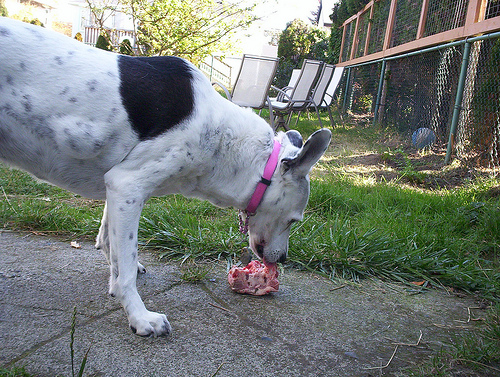

By T. J. Dunn, Jr., DVM
Understanding that there are over 160 different skin disorders of dogs, some of which create chronic difficulties, is key in helping your veterinarian solve the issue at hand. As a team, you and the veterinarian should be proactive in defining the problem accurately and in a timely manner. In order to achieve satisfactory results, it will require the doctor’s expertise and perseverance coupled with your permission and financial commitment.
There are few challenges in veterinary medicine more daunting than treating a patient for a long-term skin disorder. Chronic dermatitis cases take up about 10 percent of animal hospital file folders; and these patient folders tend to be the thickest due to the multiple pages of patient history, lab test results, biopsy reports, medications and supplements dispensed, and even dermatology specialist referral summaries. Reading through all that data you would find an oft-repeated theme … "Control is the goal since for sure there’s no cure."
To simplify a bit, there are just two kinds of skin disorders in dogs: curable and incurable. Veterinarians need to understand what is really happening to and within the skin before appropriate therapeutic strategies can be employed. Since it takes a new, healthy skin cell about four weeks to mature and be present near the skin surface even curable skin diseases may take weeks to resolve. For the incurable cases, controlling an ongoing skin disorder through selected diets, medications, shampoos, sprays, fatty acids and vitamin supplements is the best we can do.
Managing a chronic skin disorder presupposes that an exact diagnosis has been established. Making that diagnosis requires certain diagnostic protocols be done so that the doctor has a clear understanding of the pathological processes impacting the patient. A multitude of different causes may very well manifest themselves in very similar appearing visual signs.
For example "itchy skin" (pruritus) is not a diagnosis, nor is "allergy." The veterinarian needs to establish what is causing the pruritus and to what the dog is allergic. Diligent detective work has to be done and it's no small task, as evidenced by a recently published veterinary dermatology textbook that lists over 160 skin disorders of dogs!
If you ever find yourself in a situation where you leave the veterinary clinic with yet another assortment of medications or skin care products, and the plan of action is "let’s try these for a while and we’ll see if they help," you need to insist on a more proactive approach to actually obtain a definitive diagnosis. It’s time to get busy with whatever testing is needed to find the cause of the dog’s skin troubles. Only then can we recognize the curable from the controllable.
Curable Chronic Skin Disorders
Of the curable skin disorders the most commonly seen is reoccurring bacterial dermatitis where the dog displays circular patches alopecia (hair loss), scales and crusts, and tiny inflamed eruptions that evolve into additional crusty patches.
At every dermatology seminar we are reminded that most chronic bacterial dermatitis cases need to have cultures and antibiotic sensitivity tests run. And then, the appropriate antibiotic must be used for 8 to 12 weeks and sometimes much longer.
Healthy dogs seldom develop bacterial dermatitis, therefore underlying predisposing factors should be considered. (My experience is that a poor quality diet is often a factor.)
Other causes of curable but chronic skin disorders are Malassezia (yeast) infections, seen very commonly in Cocker Spaniels and West Highland White Terriers. Malassezia will cause a greasy and odorous skin. Fungal (ringworm) infections, seborrhea (oily and flaky skin) due to low fatty acid and protein in the diet, and dermatitis/alopecia due to parasites such as fleas and mites.
These curable disorders, if not properly treated, can be present throughout the dog’s life and can be mistakenly assumed to be incurable!
Incurable Skin Disorders
The incurable, chronic skin disorders can be a nightmare for the unfortunate dog and frustrating to the veterinarian and dog owner. Hormonal imbalances such as hypothyroidism in Golden Retrievers and Cushings disease (adrenal gland disorder) often seen in small breeds, generally are not curable but be managed and will display remarkable improvement once proper therapy is instituted.
Chronic dermatitis due to flea saliva, food allergy, and contact or inhalant allergy will miraculously vanish once we discover the offending antigen and then prevent dog-antigen contact.
Disorders such as pemphigus are some of the most frustrating chronic and incurable skin problems of dogs. These occur when the dog’s immune functions target his own tissues for destruction, also known as an autoimmune skin diseases.
Atopy, also called allergic inhalant dermatitis, can mimic other itchy, destructive skin disorders and may require life-long therapy to control. A newly approved use of cyclosporine has shown dramatic improvement in atopic patients.
Hereditary disorders of the skin are not curable. A wide variety of supplements and topical therapies may be palliative. The severity of inherited skin problems ranges from trivial annoyances, such as canine acne commonly seen in Doberman Pinschers, to the nearly unbearable skin and muscle destruction that occurs with dermatomyositis most often seen in Collies and Shelties.
Icthyosis, an inherited severe thickening of the skin that creates oily crusts and scales is another nasty inherited skin disorder that shows up at an early age and persists lifelong.
If your dog requires repeat visits to the veterinarian for "a skin problem" and you do not have a name for what type of skin problem is present, you owe it to your dog to get a diagnosis. In short, you must be proactive and persistent in achieving an understanding of what is causing the chronic dermatitis. You may consider a visit to a dermatology specialist, too.
Remember, only after a diagnosis is made can effective measures be initiated to cure or control the problem.
"Cortisone" drugs such as prednisone, triamcinolone, dexamethasone, and long acting cortisone injections are much like a two-edge sword. Under certain conditions they can save a dog’s life. The dark side is that misuse is common.
One reason "cortisone shots" or pills are so widely used for skin disorders is that in some patients, especially when a precise diagnosis has not been established, its use can dramatically improve the patient’s comfort and appearance.
A common example of misuse occurs in the sarcoptic mite patient that is mistakenly assumed to suffer from a severe allergy. Dramatic improvement seems to occur, unfortunately it is short lived … and more cortisone is prescribed and cycles of treatment lead to a dependence on the cortisone. The patient’s treatment becomes as damaging as the original problem!
The message is this: cortisone-like medications are to be used with caution.
It always amazes me how stoic and accepting dogs are while enduring endless severe pruritus, open sores and scabs, skin infections and cancer. Their courage should inspire us to be firm in our determination to meet the challenges of chronic dermatitis.
 Disadvantages And Advantages Of Dog Boarding Solutions Online
When you possess a pet dog, each day could feel like a vaca
Disadvantages And Advantages Of Dog Boarding Solutions Online
When you possess a pet dog, each day could feel like a vaca
 Winter Walking Dangers for Cats and Dogs
If your dog or cat spends any amount of tim
Winter Walking Dangers for Cats and Dogs
If your dog or cat spends any amount of tim
 Weight Reducing Diets For Dogs (and Cats)
By T. J. Dunn, Jr., DVM
September 15, 2009
Weight Reducing Diets For Dogs (and Cats)
By T. J. Dunn, Jr., DVM
September 15, 2009
 Euthanasia... What To Expect
By T. J. Dunn, Jr. DVM
You pick up that new
Euthanasia... What To Expect
By T. J. Dunn, Jr. DVM
You pick up that new
 Focusing on Protein in the Diet
By T. J. Dunn, Jr., DVM
Protein req
Focusing on Protein in the Diet
By T. J. Dunn, Jr., DVM
Protein req
Copyright © 2005-2016 Pet Information All Rights Reserved
Contact us: www162date@outlook.com